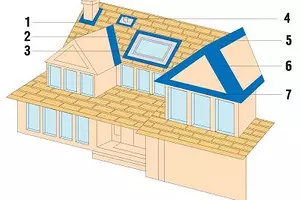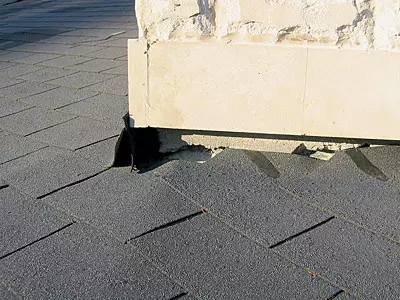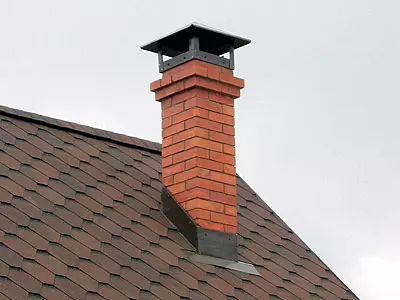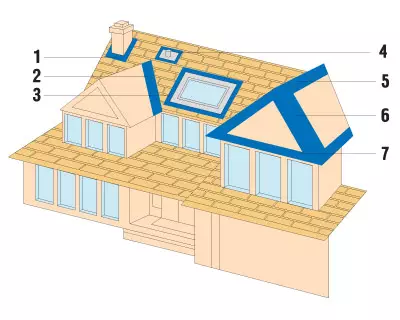


Competently made adjoining to a pipe using metal planks
In the bath, which is discussed, the roof is made of bitumen (soft) roof tiles Icopal (Finland). When laying the material builders, special attention was paid to the most "weak" places, where in case of installation errors, the roof could flow. It is an adjunct to the pipe, peaks, cornice skes.
Some of the most complex nodes are the adjuncing of roofing material to the pipe, wall, parapet IT.P. The adjoining assembly consists of two non-interchangeable elements of the planks. They are made of galvanized tin (more often with colored polymer coating: polyester, poural, plastisol). The first (rejection plank) is fixed on the base of the roof (Faneru, OSB) under roofing carpet. The second (drip) - to a brick or concrete wall above the roof material. It is placed in a bar and sealed with bitumen mastic or silicone sealant resistant to weathering. This method of installation of the adjoint allows you to avoid breaking the roofing coating caused by mobiles in the rapid system of the pipe or wall.
The thickness of the layer and the amount of adhesive composition must accurately comply with the requirements of the instruction. The principle of "more glue-riding a roof" can result in the opposite result: with an excess of bitumen mastic, an excessive softening and scattering of bitumen is possible. Almost every manufacturer of bitumen tiles has developed their compositions for sealing: Shingle Stick, Plastal, Plastal Stick from IKO (Canada), K-36 from Katepal (Finland), "bitustic" from TEGOLA (Italy), "Eureka", "Rebax- M "and" Fixer "from Technonikol (Russia) IDR.
Rights of the roof are protected by metal cornice and end straps over the lining layer. Metal strips are placed with the adhesive 5cm and fasten with roofing nails in 10-12 cm increments, in places overlap - 3cm. In the absence of a bar on the cornice, the water will fly under the roof, which will lead to the rotting of the starting board.
To seal the place of passage through the roof of the antenna, the release of the fan riser, flagpole, etc. use special passing elements (the widest range of this type of product under the trademark Vilpe has developed the Finnish company SK-TUOTE OY). For pipes with a diameter of up to 160mm, located on the roof from bituminous tiles, the huopa-felt passing elements are intended (installed at the installation of the roof under the layer of the finishing material) and Classic (fasten over the roofing coating on the finished design). Seals for sealing roofing penetrations, made of meteo and ozone-resistant EPDM rubber, have a cone form. Before mounting, they are cut to the desired diameter. From above put galvanized clamp. The elastic seal allows natural antenna movements, pipes IT.P.
The construction of the roof of the bath, about which we lead our story, does not imply the presence of endanda (the suspension, which forms the intersection of the roof rods), which significantly simplified the installation. After the subtractions of the UNDOVA - the second largest roof node. To seal the infants in the roofing of soft tiles, a lining carpet from a modified bitumen of 3mm thick, 100cm wide and up to 10 m wide, which is placed in the center of the Undova are used. It is fixed along the edges with the help of roofing nails with an enlarged hat. They should be signed so that the hat is on the same level with the lining layer, and not crashed into it. After mounting the lining carpet, start laying the bitumen tiles on the end. It can be carried out in three ways: open, "braided" or closed.
For the installation of the end, the special rolled material for infants (electrical carpet) from the modified bitumen is used in an open way. It has on top of a stone sprinkling of the same color as the main tile, chosen for the roof. After laying an end carpet, the tile can be cut off on two lines made by chalk. They are leading from the skate to the eaves, retreating from the Endow's axis to each side by 15 cm. You should also cut off the 5-centimeter triangle from the top angle of the tiles sheet for the direction of water in Enda. Then the 5-centimeter strip of a special bituminous sealant is applied to the edge of each tile sheet and nailed with nails at a distance of 5cm from the lines-filtered chalk.
Very nice (if the installation is made competently) it looks Endow, made by the weave method. Tiles are installed over the intersection of the roof rods. The latter tile sheet is at least 30cm on the opposite plane of the roof and additionally fix the nail in the upper corner. Before mounting with nails, the tile is tightly pressed against Enda. Slit material should be at a distance of at least 15 cm from the central line of Endov. This method of installation of funds is the most complicated, as it is necessary to take into account the difference in slopes of the skates.
The method of closed rtanda (with trimmed) is suitable for roofs with an inclination angle over 23. The first row should be intertwined (to go 25cm and more on the plane of the neighboring slope). On the edge of each sheet of tiles, crossing Undov, additionally driven the nail. After installing the roofing material, the chalk shall be drawn at a distance of 5 cm from the central line of the rtend on the coated skate. Next, the tile is tiled onto the second slope of the roof, cut off its chalk markup and remove a 5-centimeter triangle from the top corner of the tiles sheet for the direction of water in Enda. Complete installation by sizing the edge of each tiled leaf adjacent to Endament, bituminous sealant.
Another zone of possible leakage of the roof is located in the installation site of the attic window. To ensure the waterproof of the roofing, use the salary of special gutters located around the perimeter of the window. The salary is a drainage device that prevents rainwater and snow to enter the junction of the frame and roof.
Problem places when installing the roof:

2.Endova
3. Facility installation of an attic window
4. Imventive output
5.kone
6.Came
7. Carnation Svez
The editors thanks the company "Krovlyster" for help in preparing the material.
